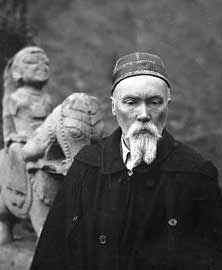THE WORK IN THE KULLU VALLEY
|
The invaluable scientific materials gathered by the expedition needed to be systematized and studied. The Roerichs settled in the north of India in the Western Himalayas, in a very picturesque valley by the name of Kullu. There they created a scientific research institute, which was named “Urusvati” (from the Sanskrit: “The Light of the Morning Star”) in honor of Helena Roerich. This is what the Great Teacher called her. George Roerich became the director of the Institute.
The Institute carried on vast and varied investigations: the translation of rare ancient books into European languages; the study of half-forgotten dialects and the ancient art of the Asian peoples; the application of officinal plants, the search for a cure for cancer; the study of Tibetan medicine, cosmic rays, and archaeological excavations; the gathering of botanical and zoological collections — this is but an incomplete list of the work carried out at Urusvati.
The Institute maintained contact with many scientific establishments all over the world. According to the working plan of the Institute, in the years 1934 to 1935, Nicholas and George Roerich organized an expedition to Manchuria and China. Urusvati functioned successfully up to the beginning of the Second World War, when all international contacts were destroyed, and the Institute had to be closed down.
The family stayed in Kullu till 1948, except for Svetoslav, who had left the valley three years earlier, after his marriage to the famous film actress and producer, Devika Rani. He moved with her to a suburb of the southern Indian town, Bangalore.
Every member of the Roerich family loved India, which became for them a second Homeland. This love was mutual. The Indian people treated the family with great respect. Moreover, Nicholas Roerich was called in India Maharishi, which from the Sanskrit means “Great Saint.”
Both Nicholas and Helena dreamed, however, of returning to their Homeland, Russia. They had already been separated from it for more than a quarter of a century. The Great Teachers planned that Nicholas and Helena Roerich would return to Russia, but it was necessary to wait for more favorable conditions in the Soviet Union. The Second World War came to an end, but the tensions didn’t ease: the situation in the world was quite complicated, and Russia wasn’t an exception.
Before he was able to return to his native country, Nicholas Roerich left his earthly life on the 13th of December, 1947, at the age of seventy-three.sHis passing was especially difficult for Helena Roerich. She knew, of course, that after the death of the body, life goes on; and that in the future, they would meet again in the Supermundane World. But it is very difficult to live on Earth without your closest and dearest friend, the one who is ready to support you at any given moment, with whom you have journeyed side by side on the Earthly Path — for almost half a century.
In the beginning of 1948, she wrote to her friends in America: “My heart aches from intense anguish at the loss of my best friend of many years. He responded to the call of the Great Lord at three in the morning while sleeping, in the most solemn day of the Indian calendar — Shiva’s birthday!.. His heart couldn’t stand the latest tensions and the fierce anguish it felt for the oppression of all that is cultural, which brings salvation to the young, growing generation... He will come back in a better time, to a purified field, and will finish his sowing and service to his country and to all humanity.”
Nicholas Roerich left an enormous legacy of approximately 7000 paintings in many museums of the world and more than thirty books, not counting his numerous articles on art, culture, science and philosophy.
He suggested an Idea and all his life fought for the adoption of an international treaty for the protection of cultural values during military actions. For this he proposed a special symbol: three spheres inside a circle. This international treaty was finally drafted and it was called The Roerich Pact, and the symbol received the name of The Banner of Peace. Moreover, Roerich communicated with Rabindranath Tagore, Jawaharlal Nehru (the first Prime Minister of independent India), Indira Gandhi, and other outstanding people and leaders of India in such a way that the foundation of friendship between Russia and the new independent India was laid.

